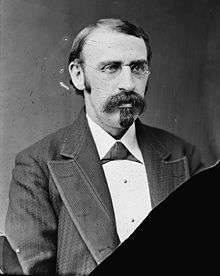Edmund William McGregor Mackey
Edmund William McGregor Mackey (March 8, 1846 – January 27, 1884) was a United States Representative from South Carolina.
Edmund William McGregor Mackey | |
|---|---|
 | |
| Member of the U.S. House of Representatives from South Carolina's 7th district | |
| In office March 4, 1883 – January 27, 1884 | |
| Preceded by | District re-established William F. Colcock before district was eliminated in 1853 |
| Succeeded by | Robert Smalls |
| Member of the U.S. House of Representatives from South Carolina's 2nd district | |
| In office May 31, 1882 – March 3, 1883 | |
| Preceded by | Samuel Dibble |
| Succeeded by | George D. Tillman |
| In office March 4, 1875 – July 19, 1876 | |
| Preceded by | Alonzo J. Ransier |
| Succeeded by | Charles W. Buttz |
| Chair of the South Carolina Republican Party | |
| In office 1880 – January 27, 1884 | |
| Preceded by | Robert Brown Elliott |
| Succeeded by | Thomas E. Miller |
| Member of the South Carolina House of Representatives from Charleston County | |
| In office November 28, 1876 – May 29, 1877 | |
| In office October 24, 1873 – March 17, 1874 | |
| 29th Speaker of the South Carolina House of Representatives disputed [1] | |
| In office 1876–1877 | |
| Preceded by | Robert B. Elliott |
| Succeeded by | William Henry Wallace |
| Sheriff of Charleston County | |
| In office 1868–1872 | |
| Personal details | |
| Born | March 8, 1846 Charleston, South Carolina |
| Died | January 27, 1884 (aged 37) Washington, D.C. |
| Political party | Republican (until 1874, 1876–onward) Independent Republican (1874–1876) |
| Profession | lawyer, politician |
Life and career

Born in Charleston, his father was Dr. Albert Mackey, who was the primary founder of Scottish Rite Freemasonry.
Edmund became a representative after the end of the American Civil War. An active Republican, he was nominated to be a delegate from Charleston for the constitutional convention of South Carolina in 1868. He was admitted to the bar in 1868 and practiced law in Charleston while also serving as sheriff and alderman.
Mackey was elected as a Republican to South Carolina House of Representatives in 1872. He campaigned successfully in 1874 as an Independent Republican for the Second Congressional District. The Forty-fourth Congress declared his seat vacant on July 19, 1876.
He was elected again to the South Carolina House of Representatives in 1876 and claimed to be the Speaker after a tumultuous campaign in the state, marked by violence and intimidation. Republicans disputed the election of Democratic Representatives from Edgefield and Laurens counties because of massive fraud in the election and barring of freedmen from the polls by Democratic Party Red Shirts.[2] Following the South Carolina Supreme Court's decision to allow seating of elected legislators from Edgefield and Laurens counties, rival state governments assembled. Mackey and the Republican legislators occupied the South Carolina State House with the support of Federal troops.
The order of President Hayes to remove Federal troops from South Carolina on April 10, 1877, a result of a political compromise ended the Republicans' struggle to control state government. The Democrats annulled the election of representatives from Charleston County, including Edmund Mackey.
Mackey continued to be active in public life serving as an assistant United States attorney for South Carolina from 1878 to 1881. Mackey attempted to win election as a Republican to the U.S. House of Representatives from South Carolina, but lost the election against Michael P. O’Connor for the 2nd congressional district in 1878 and failed to have the Democratic-controlled House overturn the election. With the Republican takeover of the House for the Forty-seventh Congress, Mackey succeeded in replacing Samuel Dibble for the House seat. Re-elected in 1882 from the Seventh Congressional District, Mackey died during the term in Washington, D.C. on January 27, 1884.
Citations
- https://bioguideretro.congress.gov/Home/MemberDetails?memIndex=M000024
- Eric Foner, Reconstruction: America's Unfinished Revolution, 1863-1877, New York: Perennial Classics, 2002, p.575
References
- Reynolds, John S. (1969). Reconstruction in South Carolina. Negro University Press. ISBN 0-8371-1638-4.
External links
| U.S. House of Representatives | ||
|---|---|---|
| Preceded by Alonzo J. Ransier |
Member of the U.S. House of Representatives from South Carolina's 2nd congressional district 1875–1876 |
Succeeded by Charles W. Buttz |
| Preceded by Samuel Dibble |
Member of the U.S. House of Representatives from South Carolina's 2nd congressional district 1882–1883 |
Succeeded by George D. Tillman |
| Preceded by District re-established |
Member of the U.S. House of Representatives from South Carolina's 7th congressional district 1883–1884 |
Succeeded by Robert Smalls |